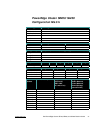
support.dell.com Dell PowerEdge Cluster SE100, SE200, and SL200 Platform Guide 7
• NICs
— You can install NICs in any available PCI slot.
• DRAC 2
— If you are currently using a DRAC 2 or plan to use one in the future, install it
in PCI slot 6.
NOTE: To make sure that the SCSI or RAID controller attached to the boot drives
initializes first, you may have to change the scan order of the PCI bus, if the BIOS sup-
ports this option, or change the order of the RAID, NIC, and DRAC 2. Performing
these tasks ensures that Windows numbers the boot drives in the proper sequence.
Adding Peripherals Required for PowerEdge 2450 Cluster
Nodes
WARNING: Hardware installation should be performed only by trained
service technicians. Before working inside the computer system, see the
safety instructions in your PowerEdge system documentation to avoid a
situation that could cause serious injury or death.
The following list provides PCI slot assignment information for the system’s buses,
RAID controllers, NICs, and DRAC 2.
NOTE: The PERC 2/DC comes fitted with an ISA retainer (the extension bracket at the
edge of the PCI card) to allow it to fit into a full-length ISA expansion slot. You may
need to remove the ISA retainer from systems that use full-length PCI expansion
slots. To remove the ISA retainer, use a Phillips screwdriver to remove the two screws
that fasten the retainer to the PERC 2/DC.
• PCI buses
— PCI bus 1: PCI slots 1 through 3 are 32-bit, 33-MHz
• RAID controllers
— RAID controllers can be installed in any available PCI slot.
• NICs
— NICs can be installed in any available PCI slot. Dell recommends that Giganet
cLAN adapters be installed in PCI slots 1 or 2.
• DRAC 2
— If you are currently using a DRAC 2 or plan to use one in the future, install it
in PCI slot 2.
NOTES: If you plan to use a DRAC 2, one PCI slot is available for a PERC 2/DC RAID
controller for shared storage.
To make sure that the SCSI or RAID controller attached to the boot drives initializes
first, you may have to change the scan order of the PCI bus, if the BIOS supports this
option, or change the order of the RAID, NIC, and DRAC 2. Performing these tasks
ensures that Windows numbers the boot drives in the proper sequence.


















